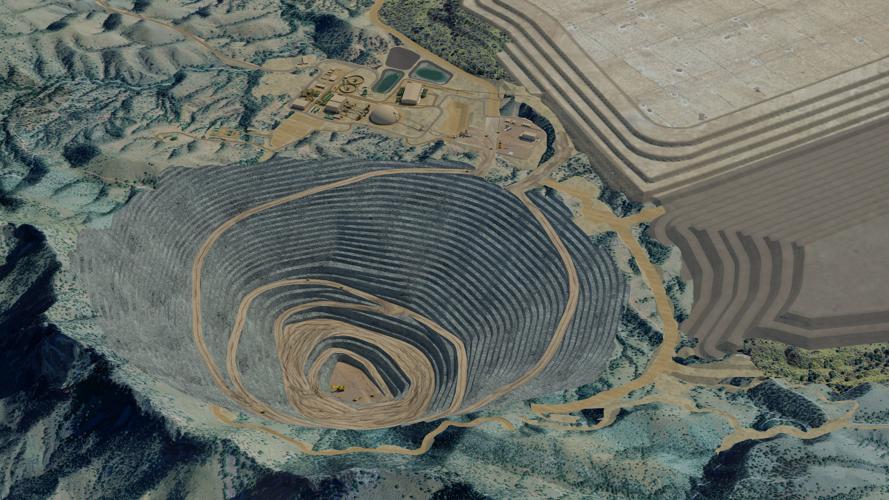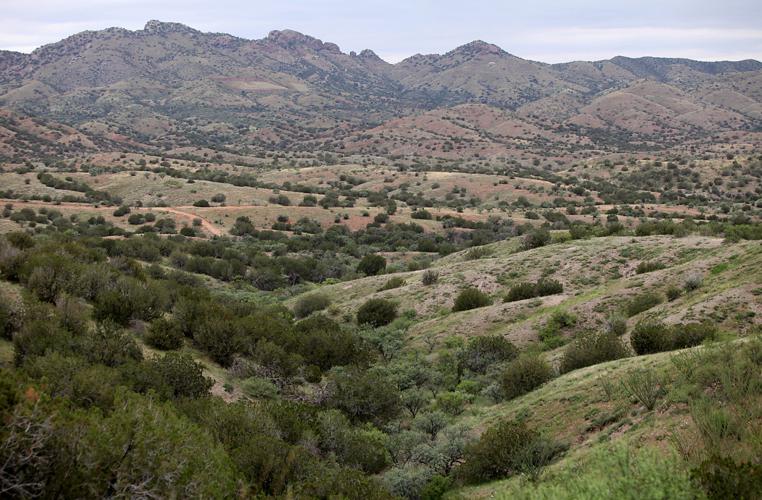Hudbay Minerals and the U.S. Forest Service won’t appeal a federal appeals court ruling blocking construction of the Rosemont Mine, ending a major legal case but not closing the controversy over the mine itself.
The mining company and the federal agency let pass a Nov. 22 legal deadline for appealing the 9th Circuit Court of Appeals ruling from May 2022 without acting. Their inaction ceded the hard-fought battle to mine opponents, which include three tribes and four environmental and conservation groups. Those opponents filed suit in 2017 to stop mine construction, shortly after the Forest Service approved it.
The decision of Hudbay and the Forest Service not to appeal to the U.S. Supreme Court means Hudbay can’t bury nearly 2 billion tons of mine waste rock and tailings on Coronado National Forest land. Hudbay has not, however, ruled out trying to find a legal path later to allow that.
The 9th Circuit upheld a potentially precedent-setting ruling from U.S. District Judge James Soto in Tucson that the Forest Service acted “arbitrarily and capriciously” in approving the mine. Rosemont is planned for the east slope of the Santa Rita Mountains, about 30 miles southeast of Tucson.
After a three-judge panel for the 9th Circuit voted 2-1 in May to uphold Soto’s ruling, Hudbay requested a rehearing before the 9th Circuit. But the same panel denied the request on Aug. 22, setting up the Nov. 22 deadline for the company and the Forest Service to appeal to the Supreme Court. Such an appeal must be filed 90 days after the final appellate court ruling.
Soto and the 9th Circuit panel majority overturned the service’s decision to let Hudbay dispose waste rock on 2,447 acres of Coronado National Forest land. The district and appellate rulings found that Hudbay and the Forest Service failed to show the company had valid mining claims on this land, because no valuable mineral deposits have been found there.
Now focusing on west slope first
However, these two rulings will only delay and not halt Hudbay’s efforts to build a copper mine in the Santa Ritas — efforts that have now stretched 17 years and involved a second company that first tried to build Rosemont before selling to Hudbay in 2014.
In response to questions from the Star, Hudbay said it now plans to first concentrate on getting a copper mine going on private land it owns on the Santa Ritas’ west slope. The company continues to say it ultimately wants to also mine copper from the east slope, and to work both slopes of that mountain range in two phases. The mining would last 44 years — 16 years for the first phase and 28 years for the second.
Toronto-based Hudbay now calls the entire proposed mine project Copper World. It has renamed the east slope Rosemont Mine project the East Pit. The open pit it has planned to dig there stretches well over a mile wide in diameter and drops 3,000 feet underground.
But it said it will not start seeking permits for the second phase, which will require federal permitting for the waste disposal, until it has gotten the first phase of mining in operation. Getting the first phase moving is likely to take several years.
Hudbay already owns 4,500 acres on both sides of the mountain range. Since spring, it has cleared land and graded for the first phase. But to get the first phase underway, it needs an air quality permit and an aquifer protection permit from the Arizona Department of Environmental Quality.
It also is trying to buy 200 acres of state land in the west slope area for various purposes. It also needs approval from the U.S. Bureau of Land Management to build a pipeline to take mine tailings from the east slope area through BLM land over to the west slope for disposal. All of these efforts will face strong opposition from environmentalists and in some cases tribes.
“Our team is fully committed and focused on continuing the permitting process for our private land project, Copper World. Phase I of Copper World will require Hudbay to obtain state and local permits to begin operations. These permits will require the project to meet all environmental standards and include monitoring and bonding requirements to ensure compliance,” Hudbay said in a statement to the Star.
Will still look for a legal way
The company will dump its waste rock and tailings on private land for the Phase 1 project but will again seek federal permission to put the waste material on federal land for the second phase, it said. It said it still sees a path to winning such approval despite the unfavorable court rulings, although that position drew skepticism from John Leshy, a former top federal government attorney who has served as an informal legal adviser to mine opponents.
“The Ninth Circuit decision held only that the Forest Service did not properly approve the Rosemont project; not that it could not have done so in exactly the same configuration and subject to the same regulations,” Hudbay said.
Forest Service spokeswoman Starr Farrell declined to say why the service chose not to appeal the 9th Circuit Court ruling, adding the case remains in litigation “and so we are unable to supply further information.” She didn’t explain her litigation comment.
Responding to Hudbay’s statement that it will still try to dispose of wastes on federal land, Steve Brown, a co-president of the opposition group Save the Scenic Santa Ritas, said it “confirms that they will continue to seek ways to circumvent the laws governing the use of public land. We have confidence that over the long run, the American justice system will continue to protect the public from those whose only interest is to increase their private profits ... .”
Save the Scenic Santa Ritas is one of the conservation groups that filed the successful lawsuit. Other environmental plaintiffs included the Arizona Mining Reform Coalition and the Grand Canyon Chapter of the Sierra Club. Tribal plaintiffs included the Pascua-Yaqui and Hopi tribes and the Tohono O’Odham Nation.
Allison Melton, an attorney for the Center for Biological Diversity, another plaintiff, added, “At least Hudbay had the sense to realize even this Supreme Court wasn’t likely to let it run roughshod over federal mining laws. The Forest Service should never have approved the Rosemont mine. The Santa Ritas provide drinking water for metro Tucson and habitat for jaguars, ocelots and many rare animals and plants. These mountains aren’t a toxic waste dump.”
1872 Mining Law
At the core of the court rulings that sank Hudbay’s efforts to dump its waste rock on federal land is the same U.S. law that has opened up much of the West to mining — the 1872 Mining Law.
The law allows U.S. citizens to have mining rights, after payment of small fees, to explore for and remove “valuable minerals” from federal land, wrote 9th Circuit Judge William Fletcher, who wrote the majority opinion in the May 2022 ruling against Hudbay and the Forest Service.
“When first enacted, the Mining Law was exceedingly broad, encompassing almost all federal land in the American West, and encompassing a wide range of valuable minerals,” Fletcher wrote.
While the law’s scope has been substantially reduced by court rulings and various federal statutes, the Mining Law remains in effect for much federal land and for many minerals, including copper, he wrote.
Once a miner discovers a valuable mineral deposit on federal land, Sections 23 and 26 of the Mining Law allow the miner to file “unpatented mining claims” on that land, wrote Fletcher. Unpatented claims, which include those on the Forest Service land Hudbay wanted to dump wastes for Rosemont, allow their owner to explore for and extract minerals from that land without taking ownership of it.
“But the claim is invalid and confers no right without a ‘discovery’ of ‘valuable minerals’ on the claim,” Fletcher added. “If a mining claim is invalid, a miner has no right, possessory or otherwise, in connection with the land.”
The proposed Rosemont Mine open pit, covering 955 acres, includes both private and federal land on which there is no dispute over the validity of the mining claims. But on the 2,447 acres of national forest on which Hudbay proposed to dispose its waste rock and tailings, “undisputed evidence ... shows that no valuable minerals have been found,” Fletcher wrote.
In its statement to the Star, however, Hudbay noted that the 9th Circuit, while ruling the Mining Law doesn’t authorize use of federal land for waste rock disposal if it lacks federal mining claims, declined to decide whether the Forest Service could approve mining on land without such claims under a separate set of federal regulations. The 9th Circuit ruling kicked that question back to the Forest Service, saying, “These are decisions that must be made in the first instance by the Service, rather than by our court.”
Dissenting in the case, Judge Danelle Forest wrote that these Forest Service applications are “legally applicable to all legitimate mining activities regardless of whether they are on valid claims,” Hudbay noted.
But Leshy, a retired law school professor who was an Interior Department solicitor during the Clinton administration, told the Star the 9th Circuit ruling leaves open only “a very narrow crack for the Forest Service to decide” that its rules allow Hudbay to dump mine waste on land with invalid claims. The ruling casts a lot of doubt on whether that’s possible, by concluding that neither the 1872 Mining Law nor the separate, 1955 Surface Resources Act authorizes such uses, he said.
“That leaves the Forest Service only an argument that its general authority over national forest land allows it to decide to give Rosemont authority to dump the waste on such land, and that’s an uphill argument to say the least,” Leshy said.
Brown, of Save the Scenic Santa Ritas, added, “Hudbay is attempting to divert attention from the fact that they lost their case. Put simply: They lost. The people of Arizona, and America, won. We will work hard on every front to assure that they continue to lose.”
Watch a test drive of Caterpillar's first battery electric mining haul truck at the Tucson Proving Ground in Green Valley.






